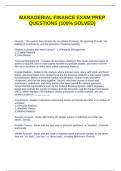MANAGERIAL FINANCE EXAM PREP
QUESTIONS (100% SOLVED)
Finance - The system that includes the circulation of money, the granting of credit, the
making of investments, and the provision of banking facilities
Finance is divided into what 3 areas? - 1.) Financial Management
2.) Capital Markets
3.) Investments
Financial Management - Focuses on decisions relating to how much and what types of
assets to acquire, how to raise capital needed to purchase assets, and how to run the
firm as to maximize its value (also called corporate finance)
Capital Markets - Relate to the markets where interest rates, along with stock and bond
prices, are determined. Also studied here are the financial institutions that supply capital
to businesses. Banks, investment banks, stockbrokers, mutual funds, insurance
companies, and the like bring together "savers" who have money to invest and
businesses, individuals, and other entities that need capital for various purposes.
Governmental organizations such as the Federal Reserve System, which regulates
banks and controls the supply of money, and the Securities and Exchange Commission
(SEC), which regulates the trading of stocks and bonds in public markets, are also
studied as part of ___________.
Investments - Relate to decisions concerning stocks and bonds and refer to a number of
activities:
1.) Security Analysis
2.) Portfolio Theory
3.) Market Analysis
Security Analysis - Deals with finding the proper values of individual securities (ex.
stocks, bonds)
Portfolio Theory - Deals with the best way to structure portfolios, or "baskets", of stocks
and bonds.
Market Analysis - Deals with the issue of whether stock and bond markets at any given
time are "too high," "too low," or "about right". Includes Behavioral Finance
, Behavioral Finance - Where investor psychology is examined in an effort to determine
have been bid up to unreasonable heights in a speculative bubble or driven down to
unreasonable lows in a fit of irrational pessimism
Board of Directors - The _______________ is the top governing body, and the
chairperson of the board is generally the highest-ranking individual.
CEO - The ______________ comes second on the organization chart, but note that the
chairperson of the board often also serves as the CEO.
Chief Operating Officer (COO) - Below the CEO is the __________________, who is
often also designated as a firm's president. The ________ directs the firm's operations,
which include marketing, manufacturing, sales, and other operating departments.
Chief Financial Officer (CFO) - The _____________, who is generally a senior vice
president and the third-ranking officer, is in charge of accounting, finance, credit policy,
decisions regarding asset acquisitions, and investor relations, which involves
communications with stockholders and the press.
Sarbanes-Oxley Act - If the firm is publicly owned, the CEO and the CFO must both
certify to the SEC that reports released to stockholders, and especially the annual
report, are accurate. If inaccuracies later emerge, the CEO and the CFO could be fined
or even jailed. This requirement was instituted in 2002 as a part of the
_______________
What are the 4 main forms of business organizations? - 1.) Proprietorships
2.) Partnerships
3.) Corporations
4.) Limited Liability Companies (LLCs) and Limited Liability Partnerships (LLPs)
Proprietorship - An unincorporated business owned by one individual
3 Advantages of Proprietorships - 1.) Easy and inexpensive to form
2.) They are subject to few government regulations
3.) Subject to lower income taxes than corporations
3 Limitations of Proprietorships - 1.) Proprietors have unlimited personal liability for the
business' debts, so they can lose more than the amount of money they invested in the
company.
2.) The life of the business is limited to the life of the individual who created it; and to
bring in new equity, investors require a change in the structure of the business.
3.) Because of the first two points, proprietorships have difficulty obtaining large sums of
capital; hence, proprietorships are used primarily for small businesses.
Partnership - a legal arrangement between two or more people who decide to do
business together. _______________ are similar to proprietorships in that they can be





